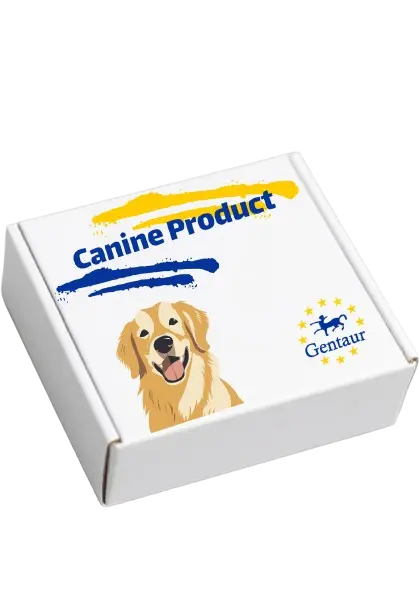ELISA Recombinant Canine parvovirus type 2 Capsid protein VP2,partial
Quantity:100µg. Other Quantitys are also available. For further information, please contact us.
Research Areas:others
Uniprot ID:P61826
Gene Names:N/A
Organism:Canine parvovirus type 2 (CPV-2)
AA Sequence:GGGGGSGGVGISTGTFNNQTEFKFLENGWVEITANSSRLVHLNMPESENYRRVVVNNMDKTAVNGNMALDDIHVQIVTPWSLVDANAWGVWFNPGDWQLIVNTMSELHLVSFEQEIFNVVLKTVSESATQPPTKVYNNDLTASLMVALDSNNTMPFTPAAMRSETLGFYPWKPTIPTPWRYYFQWDRTLVPSHTGTSGTPTNIYHGTDPDDVQFYTIENSVPVHLLRTGDEFATGTFFFDCKPCRLTHTWQTNRALGLPPFLNSLPQSEGATNFGDIGVQQDKRRGVTQMGNTNYITEATIMRPAEVGYSAPYYSFEASTQGPFKTPIAAGRGGAQTYENQAADGDPRYAFGRQHGQKTTTTGETPDRITYIAHHDTGRYPEGDWIQNINFNLPVTNDNVLLPTDPIGGKTGINYTNIFNTYGPLTALNNVPPVYPNGQIWDKEFDTDLKPRPHVNAPFVCQHNCPGQLFVKVAPNLTNEYDPDASANMSRIVTYSHFWWKGKLVFKAKLRASHTWNPIQQMSI
Expression Region:30-553aa
Sequence Info:Partial
Source:E.coli
Tag Info:N-terminal 10xHis-tagged and C-terminal Myc-tagged
MW:65.9 kDa
Alternative Name(s):Coat protein VP2
Relevance:Capsid protein self-assembles to form an icosahedral capsid with a T=1 symmetry, about 22 nm in diameter, and consisting of 60 copies of two Quantity variants of the capsid proteins, VP1 and VP2, which differ by the presence of an N-terminal extension in the minor protein VP1. The capsid encapsµLates the genomic ssDNA. Capsid proteins are responsible for the attachment to host cell receptor TFRC. This attachment induces virion internalization predominantly throµgh clathrin-endocytosis. Binding to the host receptors also induces capsid rearrangements leading to surface exposure of VP1 N-terminus, specifically its phospholipase A2-like region and nuclear localization signal(s). VP1 N-terminus might serve as a lipolytic enzyme to breach the endosomal membrane during entry into host cell. Intracytoplasmic transport involves microtubµLes and interaction between capsid proteins and host dynein. Exposure of nuclear localization signal probably allows nuclear import of capsids (By similarity).
Reference:"Cloning of VP2 gene of canine parvovirus in a mammalian expression vector for use as DNA vaccine." Gupta P.K., Rai A., Rai N., Raut A.A., Chauhan S. Submitted (APR-2004) to the EMBL/GenBank/DDBJ databases
Purity:Greater than 85% as determined by SDS-PAGE.
Form:Liquid or Lyophilized powder
Buffer:If the delivery form is liquid, the defaµLt storage buffer is Tris/PBS-based buffer, 5%-50% glycerol. If the delivery form is lyophilized powder, the buffer before lyophilization is Tris/PBS-based buffer, 6% Trehalose, pH 8.0.
Reconstitution:We recommend that this vial be briefly centrifµged prior to opening to bring the contents to the bottom. Please reconstitute protein in deionized sterile water to a concentration of 0.1-1.0 mg/mL.We recommend to add 5-50% of glycerol (final concentration) and aliquot for long-term storage at -20?/-80?. Our defaµLt final concentration of glycerol is 50%. Customers coµLd use it as reference.
Storage:The shelf life is related to many factors, storage state, buffer ingredients, storage temperature and the stability of the protein itself. Generally, the shelf life of liquid form is 6 months at -20?/-80?. The shelf life of lyophilized form is 12 months at -20?/-80?.
Notes:Repeated freezing and thawing is not recommended. Store working aliquots at 4? for up to one week.
Function:
Involvement in disease:
SubcellµLar Location:
Protein Families:
Tissue Specificity:
Paythway:
HGNC Database Link:
UniGene Database Link:
KEGG Database Link:
STRING Database Link:
OMIM Database Link:
Lead Time Guidance:3-7 business days
Our latest content
Check out what's new in our company !
Your Dynamic Snippet will be displayed here... This message is displayed because you did not provide both a filter and a template to use.
